NED University Materials Engineering: CE3 Report on SMA Project
VerifiedAdded on 2020/03/04
|8
|1602
|182
Report
AI Summary
This report details a student's project on the synthesis and characterization of nickel-free shape memory alloys (SMAs). The project focused on creating Cu-Al-Mn SMAs using mechanical ball milling and induction melting. The report covers the project's background, objectives, the student's area of work, responsibilities, and the application of engineering knowledge. It includes discussions on the project's theoretical aspects, the experimental procedures, identified issues, and proposed solutions. The report also reviews the project's collaborative aspects and the student's contributions, providing insights into the challenges and achievements in synthesizing and characterizing these advanced materials. The student faced challenges such as the unavailability of a clean room but overcame them and was able to produce two different kinds of memory alloys for the project research process. The report concludes with plans for future work, including improvements to the experimental setup and characterization methods. The student also highlights the importance of collaboration and guidance received during the project.
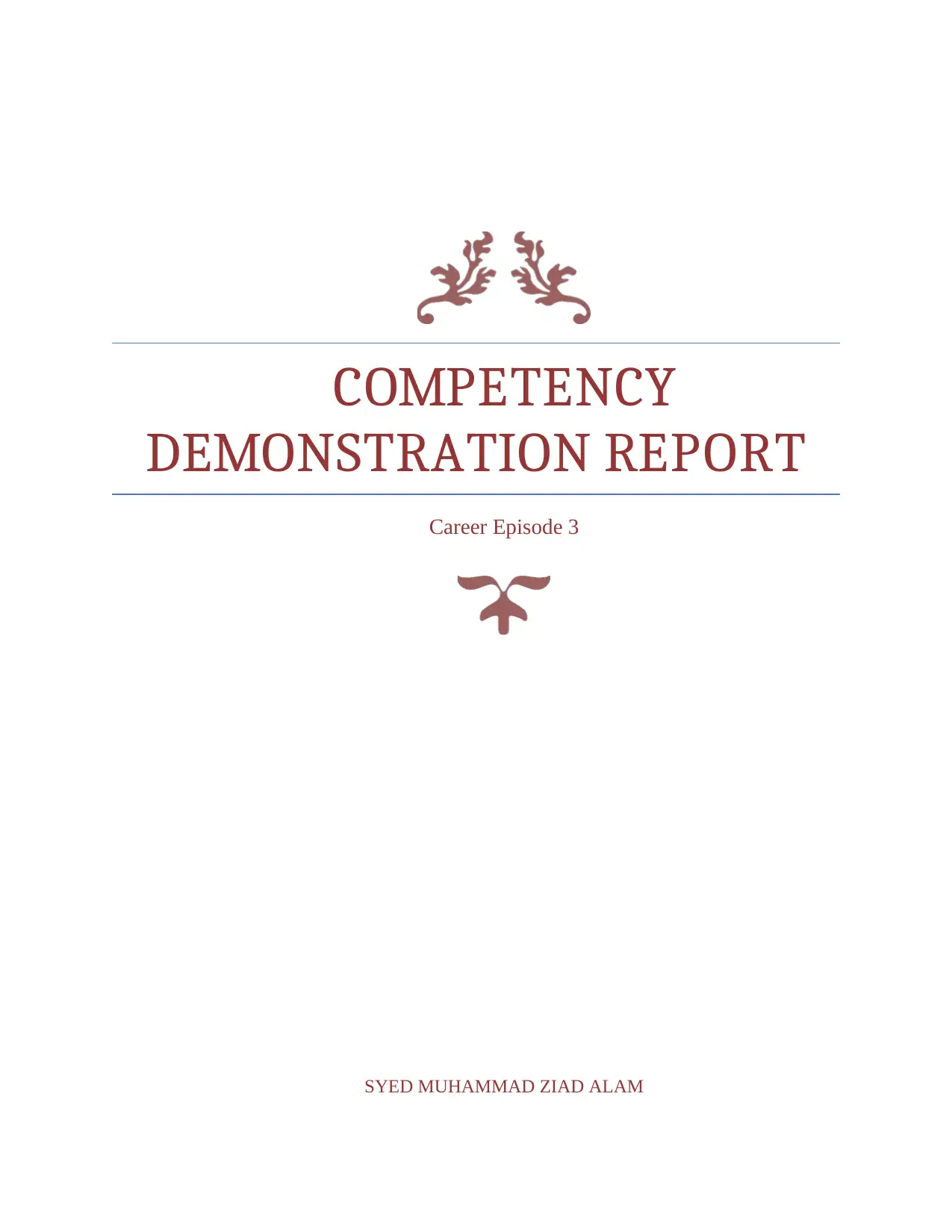
COMPETENCY
DEMONSTRATION REPORT
Career Episode 3
SYED MUHAMMAD ZIAD ALAM
DEMONSTRATION REPORT
Career Episode 3
SYED MUHAMMAD ZIAD ALAM
Paraphrase This Document
Need a fresh take? Get an instant paraphrase of this document with our AI Paraphraser
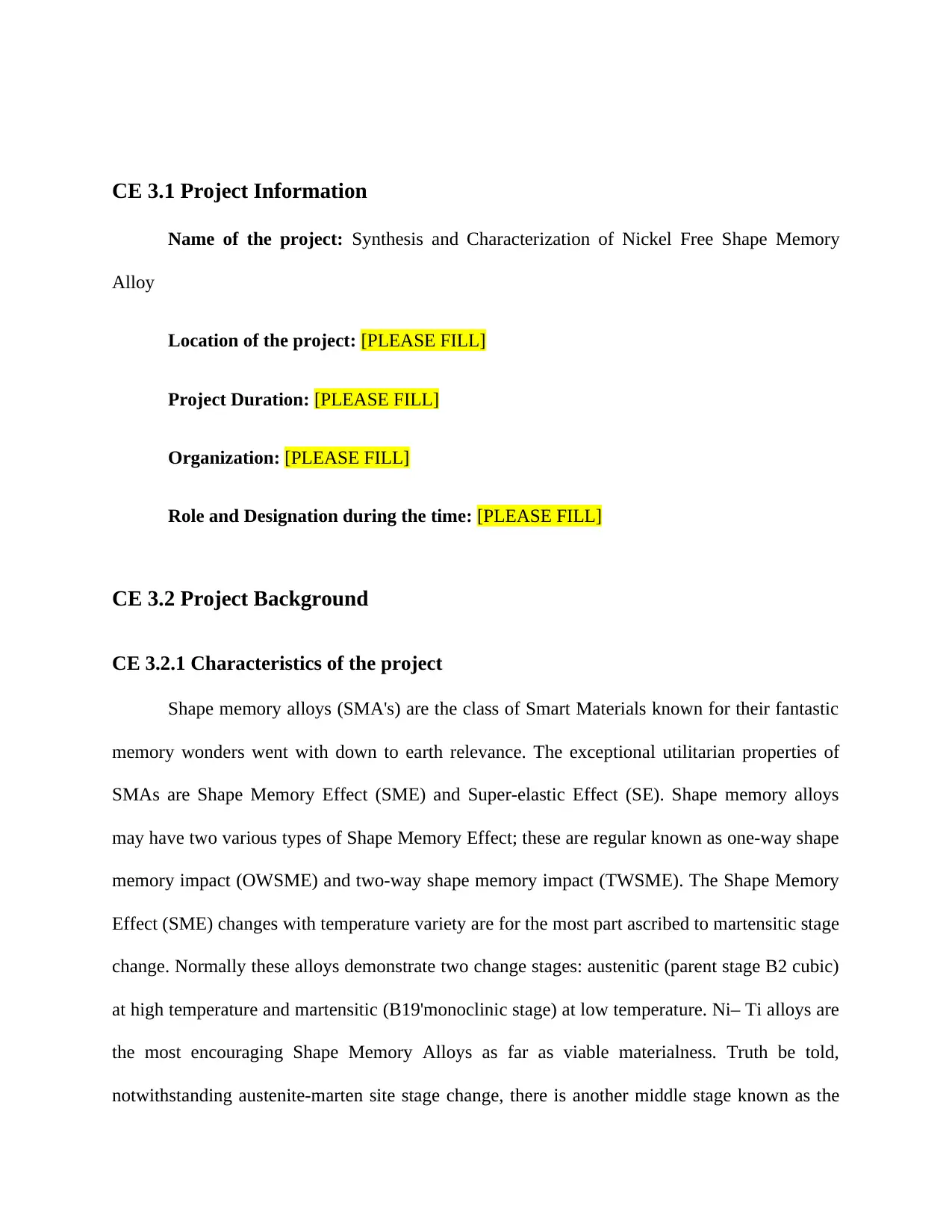
CE 3.1 Project Information
Name of the project: Synthesis and Characterization of Nickel Free Shape Memory
Alloy
Location of the project: [PLEASE FILL]
Project Duration: [PLEASE FILL]
Organization: [PLEASE FILL]
Role and Designation during the time: [PLEASE FILL]
CE 3.2 Project Background
CE 3.2.1 Characteristics of the project
Shape memory alloys (SMA's) are the class of Smart Materials known for their fantastic
memory wonders went with down to earth relevance. The exceptional utilitarian properties of
SMAs are Shape Memory Effect (SME) and Super-elastic Effect (SE). Shape memory alloys
may have two various types of Shape Memory Effect; these are regular known as one-way shape
memory impact (OWSME) and two-way shape memory impact (TWSME). The Shape Memory
Effect (SME) changes with temperature variety are for the most part ascribed to martensitic stage
change. Normally these alloys demonstrate two change stages: austenitic (parent stage B2 cubic)
at high temperature and martensitic (B19'monoclinic stage) at low temperature. Ni– Ti alloys are
the most encouraging Shape Memory Alloys as far as viable materialness. Truth be told,
notwithstanding austenite-marten site stage change, there is another middle stage known as the
Name of the project: Synthesis and Characterization of Nickel Free Shape Memory
Alloy
Location of the project: [PLEASE FILL]
Project Duration: [PLEASE FILL]
Organization: [PLEASE FILL]
Role and Designation during the time: [PLEASE FILL]
CE 3.2 Project Background
CE 3.2.1 Characteristics of the project
Shape memory alloys (SMA's) are the class of Smart Materials known for their fantastic
memory wonders went with down to earth relevance. The exceptional utilitarian properties of
SMAs are Shape Memory Effect (SME) and Super-elastic Effect (SE). Shape memory alloys
may have two various types of Shape Memory Effect; these are regular known as one-way shape
memory impact (OWSME) and two-way shape memory impact (TWSME). The Shape Memory
Effect (SME) changes with temperature variety are for the most part ascribed to martensitic stage
change. Normally these alloys demonstrate two change stages: austenitic (parent stage B2 cubic)
at high temperature and martensitic (B19'monoclinic stage) at low temperature. Ni– Ti alloys are
the most encouraging Shape Memory Alloys as far as viable materialness. Truth be told,
notwithstanding austenite-marten site stage change, there is another middle stage known as the
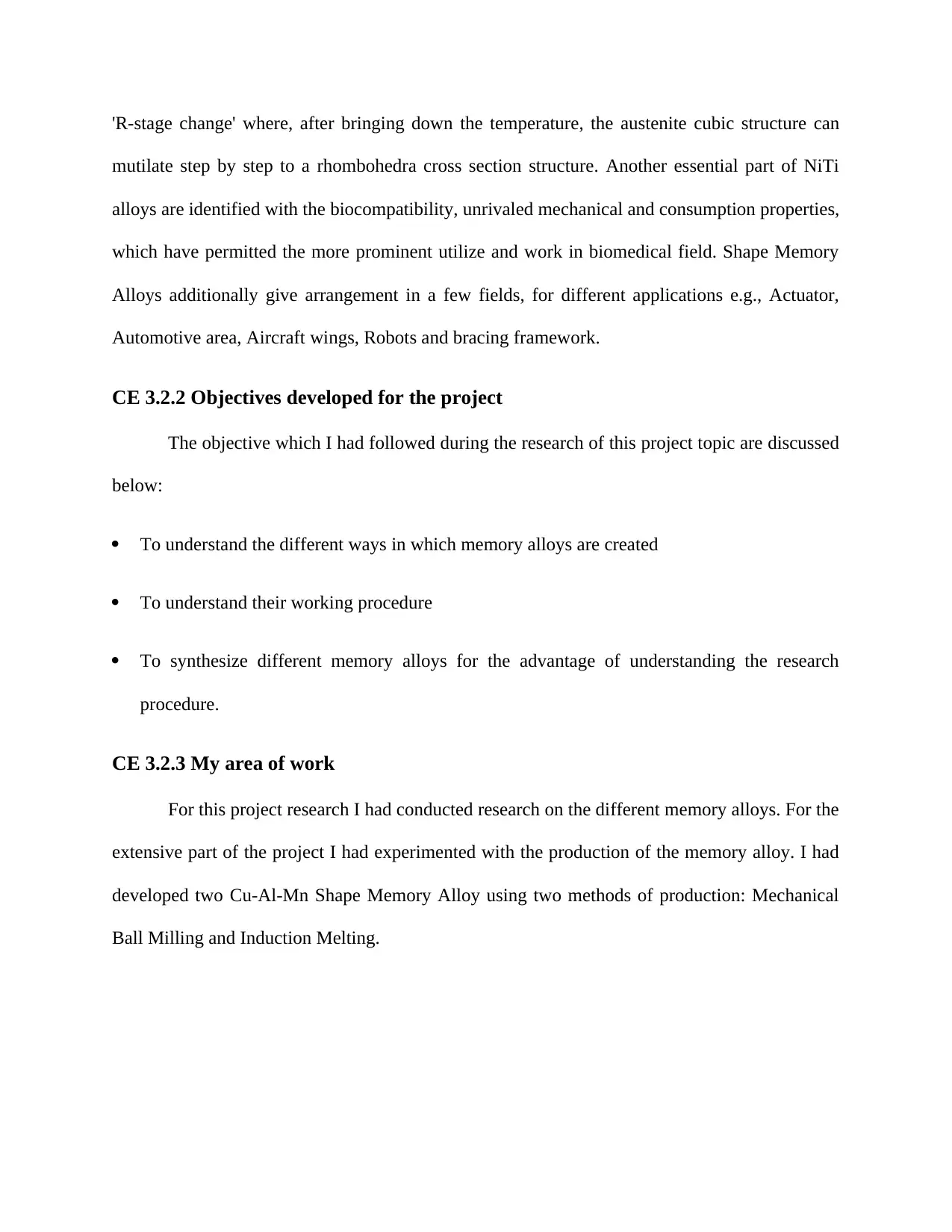
'R-stage change' where, after bringing down the temperature, the austenite cubic structure can
mutilate step by step to a rhombohedra cross section structure. Another essential part of NiTi
alloys are identified with the biocompatibility, unrivaled mechanical and consumption properties,
which have permitted the more prominent utilize and work in biomedical field. Shape Memory
Alloys additionally give arrangement in a few fields, for different applications e.g., Actuator,
Automotive area, Aircraft wings, Robots and bracing framework.
CE 3.2.2 Objectives developed for the project
The objective which I had followed during the research of this project topic are discussed
below:
To understand the different ways in which memory alloys are created
To understand their working procedure
To synthesize different memory alloys for the advantage of understanding the research
procedure.
CE 3.2.3 My area of work
For this project research I had conducted research on the different memory alloys. For the
extensive part of the project I had experimented with the production of the memory alloy. I had
developed two Cu-Al-Mn Shape Memory Alloy using two methods of production: Mechanical
Ball Milling and Induction Melting.
mutilate step by step to a rhombohedra cross section structure. Another essential part of NiTi
alloys are identified with the biocompatibility, unrivaled mechanical and consumption properties,
which have permitted the more prominent utilize and work in biomedical field. Shape Memory
Alloys additionally give arrangement in a few fields, for different applications e.g., Actuator,
Automotive area, Aircraft wings, Robots and bracing framework.
CE 3.2.2 Objectives developed for the project
The objective which I had followed during the research of this project topic are discussed
below:
To understand the different ways in which memory alloys are created
To understand their working procedure
To synthesize different memory alloys for the advantage of understanding the research
procedure.
CE 3.2.3 My area of work
For this project research I had conducted research on the different memory alloys. For the
extensive part of the project I had experimented with the production of the memory alloy. I had
developed two Cu-Al-Mn Shape Memory Alloy using two methods of production: Mechanical
Ball Milling and Induction Melting.
⊘ This is a preview!⊘
Do you want full access?
Subscribe today to unlock all pages.

Trusted by 1+ million students worldwide
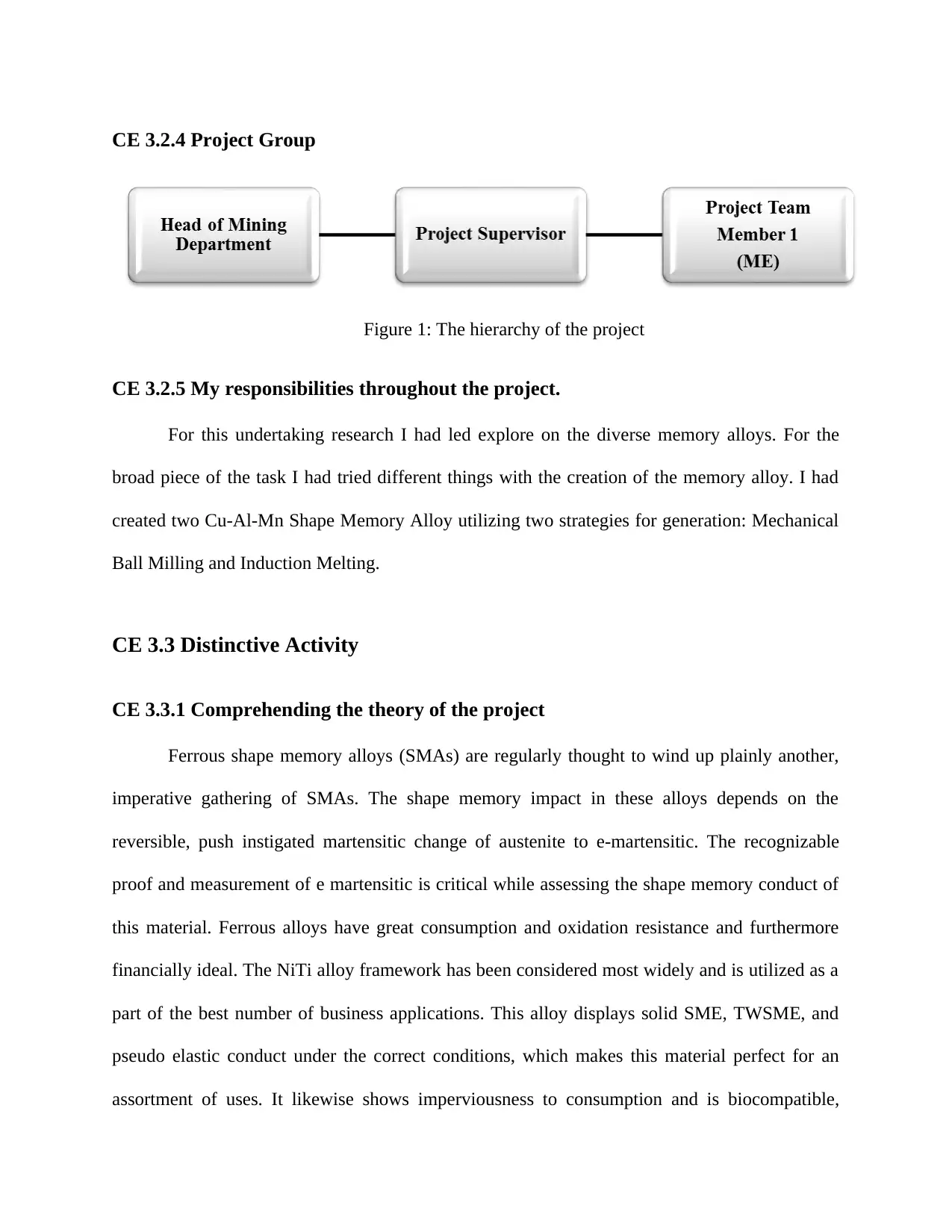
CE 3.2.4 Project Group
Figure 1: The hierarchy of the project
CE 3.2.5 My responsibilities throughout the project.
For this undertaking research I had led explore on the diverse memory alloys. For the
broad piece of the task I had tried different things with the creation of the memory alloy. I had
created two Cu-Al-Mn Shape Memory Alloy utilizing two strategies for generation: Mechanical
Ball Milling and Induction Melting.
CE 3.3 Distinctive Activity
CE 3.3.1 Comprehending the theory of the project
Ferrous shape memory alloys (SMAs) are regularly thought to wind up plainly another,
imperative gathering of SMAs. The shape memory impact in these alloys depends on the
reversible, push instigated martensitic change of austenite to e-martensitic. The recognizable
proof and measurement of e martensitic is critical while assessing the shape memory conduct of
this material. Ferrous alloys have great consumption and oxidation resistance and furthermore
financially ideal. The NiTi alloy framework has been considered most widely and is utilized as a
part of the best number of business applications. This alloy displays solid SME, TWSME, and
pseudo elastic conduct under the correct conditions, which makes this material perfect for an
assortment of uses. It likewise shows imperviousness to consumption and is biocompatible,
Figure 1: The hierarchy of the project
CE 3.2.5 My responsibilities throughout the project.
For this undertaking research I had led explore on the diverse memory alloys. For the
broad piece of the task I had tried different things with the creation of the memory alloy. I had
created two Cu-Al-Mn Shape Memory Alloy utilizing two strategies for generation: Mechanical
Ball Milling and Induction Melting.
CE 3.3 Distinctive Activity
CE 3.3.1 Comprehending the theory of the project
Ferrous shape memory alloys (SMAs) are regularly thought to wind up plainly another,
imperative gathering of SMAs. The shape memory impact in these alloys depends on the
reversible, push instigated martensitic change of austenite to e-martensitic. The recognizable
proof and measurement of e martensitic is critical while assessing the shape memory conduct of
this material. Ferrous alloys have great consumption and oxidation resistance and furthermore
financially ideal. The NiTi alloy framework has been considered most widely and is utilized as a
part of the best number of business applications. This alloy displays solid SME, TWSME, and
pseudo elastic conduct under the correct conditions, which makes this material perfect for an
assortment of uses. It likewise shows imperviousness to consumption and is biocompatible,
Paraphrase This Document
Need a fresh take? Get an instant paraphrase of this document with our AI Paraphraser
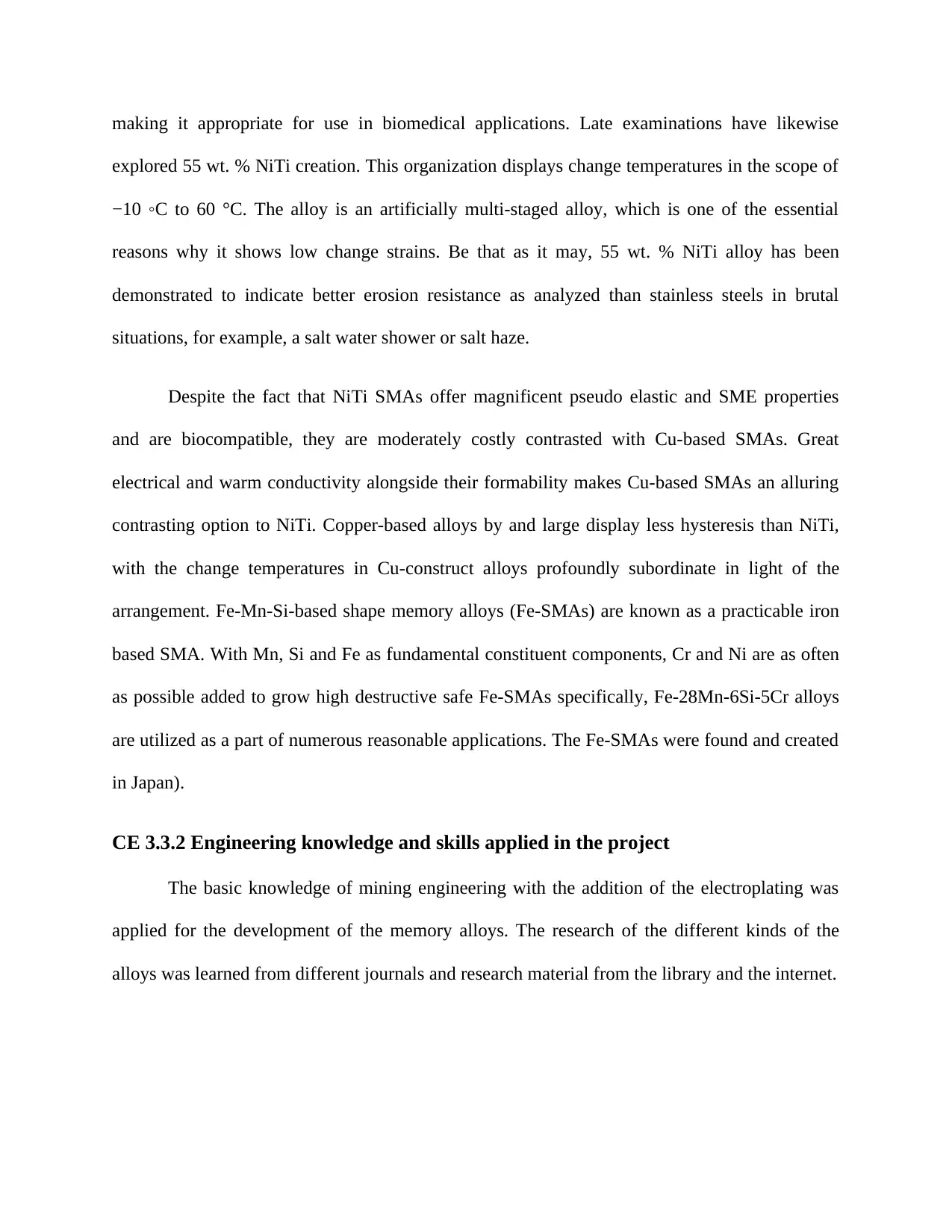
making it appropriate for use in biomedical applications. Late examinations have likewise
explored 55 wt. % NiTi creation. This organization displays change temperatures in the scope of
−10 ◦C to 60 °C. The alloy is an artificially multi-staged alloy, which is one of the essential
reasons why it shows low change strains. Be that as it may, 55 wt. % NiTi alloy has been
demonstrated to indicate better erosion resistance as analyzed than stainless steels in brutal
situations, for example, a salt water shower or salt haze.
Despite the fact that NiTi SMAs offer magnificent pseudo elastic and SME properties
and are biocompatible, they are moderately costly contrasted with Cu-based SMAs. Great
electrical and warm conductivity alongside their formability makes Cu-based SMAs an alluring
contrasting option to NiTi. Copper-based alloys by and large display less hysteresis than NiTi,
with the change temperatures in Cu-construct alloys profoundly subordinate in light of the
arrangement. Fe-Mn-Si-based shape memory alloys (Fe-SMAs) are known as a practicable iron
based SMA. With Mn, Si and Fe as fundamental constituent components, Cr and Ni are as often
as possible added to grow high destructive safe Fe-SMAs specifically, Fe-28Mn-6Si-5Cr alloys
are utilized as a part of numerous reasonable applications. The Fe-SMAs were found and created
in Japan).
CE 3.3.2 Engineering knowledge and skills applied in the project
The basic knowledge of mining engineering with the addition of the electroplating was
applied for the development of the memory alloys. The research of the different kinds of the
alloys was learned from different journals and research material from the library and the internet.
explored 55 wt. % NiTi creation. This organization displays change temperatures in the scope of
−10 ◦C to 60 °C. The alloy is an artificially multi-staged alloy, which is one of the essential
reasons why it shows low change strains. Be that as it may, 55 wt. % NiTi alloy has been
demonstrated to indicate better erosion resistance as analyzed than stainless steels in brutal
situations, for example, a salt water shower or salt haze.
Despite the fact that NiTi SMAs offer magnificent pseudo elastic and SME properties
and are biocompatible, they are moderately costly contrasted with Cu-based SMAs. Great
electrical and warm conductivity alongside their formability makes Cu-based SMAs an alluring
contrasting option to NiTi. Copper-based alloys by and large display less hysteresis than NiTi,
with the change temperatures in Cu-construct alloys profoundly subordinate in light of the
arrangement. Fe-Mn-Si-based shape memory alloys (Fe-SMAs) are known as a practicable iron
based SMA. With Mn, Si and Fe as fundamental constituent components, Cr and Ni are as often
as possible added to grow high destructive safe Fe-SMAs specifically, Fe-28Mn-6Si-5Cr alloys
are utilized as a part of numerous reasonable applications. The Fe-SMAs were found and created
in Japan).
CE 3.3.2 Engineering knowledge and skills applied in the project
The basic knowledge of mining engineering with the addition of the electroplating was
applied for the development of the memory alloys. The research of the different kinds of the
alloys was learned from different journals and research material from the library and the internet.
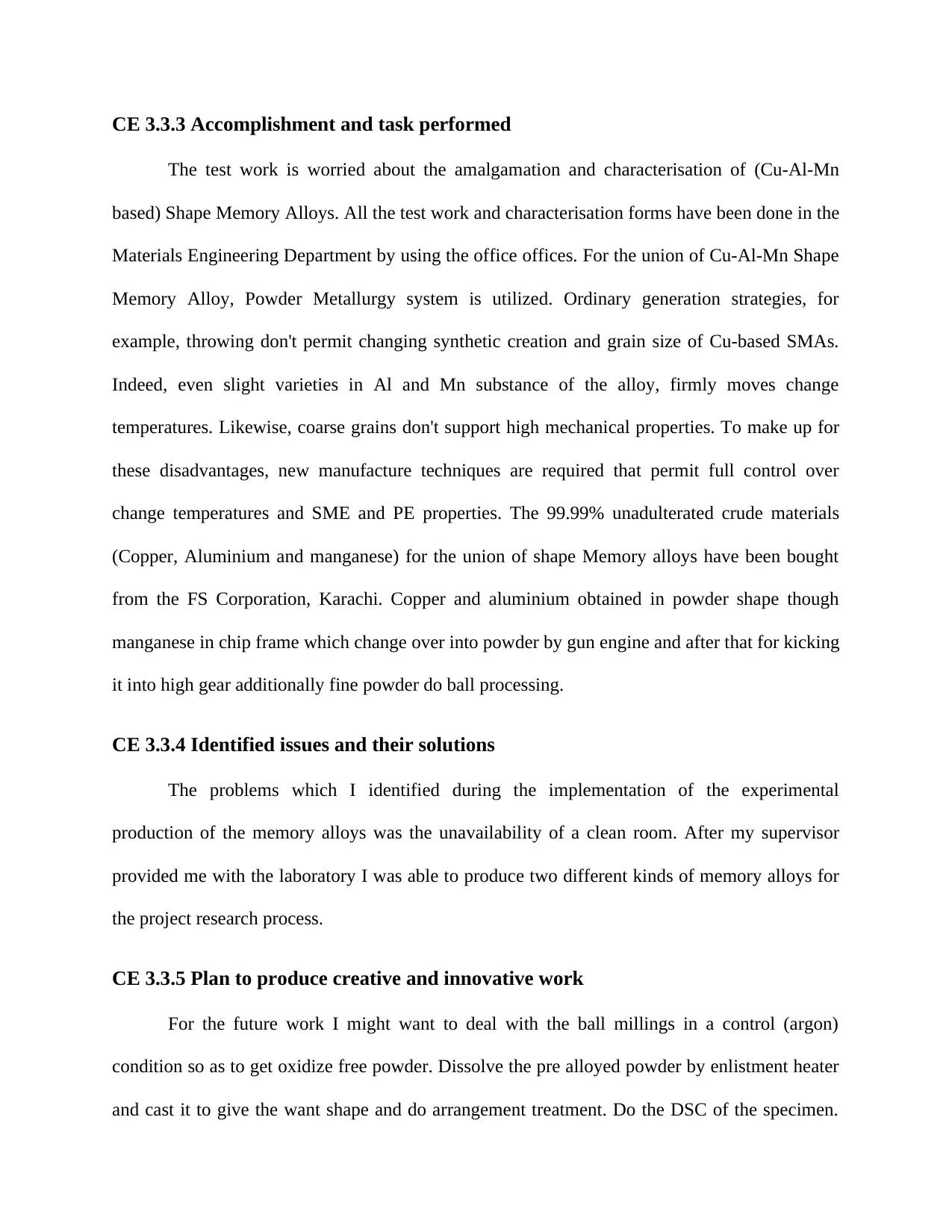
CE 3.3.3 Accomplishment and task performed
The test work is worried about the amalgamation and characterisation of (Cu-Al-Mn
based) Shape Memory Alloys. All the test work and characterisation forms have been done in the
Materials Engineering Department by using the office offices. For the union of Cu-Al-Mn Shape
Memory Alloy, Powder Metallurgy system is utilized. Ordinary generation strategies, for
example, throwing don't permit changing synthetic creation and grain size of Cu-based SMAs.
Indeed, even slight varieties in Al and Mn substance of the alloy, firmly moves change
temperatures. Likewise, coarse grains don't support high mechanical properties. To make up for
these disadvantages, new manufacture techniques are required that permit full control over
change temperatures and SME and PE properties. The 99.99% unadulterated crude materials
(Copper, Aluminium and manganese) for the union of shape Memory alloys have been bought
from the FS Corporation, Karachi. Copper and aluminium obtained in powder shape though
manganese in chip frame which change over into powder by gun engine and after that for kicking
it into high gear additionally fine powder do ball processing.
CE 3.3.4 Identified issues and their solutions
The problems which I identified during the implementation of the experimental
production of the memory alloys was the unavailability of a clean room. After my supervisor
provided me with the laboratory I was able to produce two different kinds of memory alloys for
the project research process.
CE 3.3.5 Plan to produce creative and innovative work
For the future work I might want to deal with the ball millings in a control (argon)
condition so as to get oxidize free powder. Dissolve the pre alloyed powder by enlistment heater
and cast it to give the want shape and do arrangement treatment. Do the DSC of the specimen.
The test work is worried about the amalgamation and characterisation of (Cu-Al-Mn
based) Shape Memory Alloys. All the test work and characterisation forms have been done in the
Materials Engineering Department by using the office offices. For the union of Cu-Al-Mn Shape
Memory Alloy, Powder Metallurgy system is utilized. Ordinary generation strategies, for
example, throwing don't permit changing synthetic creation and grain size of Cu-based SMAs.
Indeed, even slight varieties in Al and Mn substance of the alloy, firmly moves change
temperatures. Likewise, coarse grains don't support high mechanical properties. To make up for
these disadvantages, new manufacture techniques are required that permit full control over
change temperatures and SME and PE properties. The 99.99% unadulterated crude materials
(Copper, Aluminium and manganese) for the union of shape Memory alloys have been bought
from the FS Corporation, Karachi. Copper and aluminium obtained in powder shape though
manganese in chip frame which change over into powder by gun engine and after that for kicking
it into high gear additionally fine powder do ball processing.
CE 3.3.4 Identified issues and their solutions
The problems which I identified during the implementation of the experimental
production of the memory alloys was the unavailability of a clean room. After my supervisor
provided me with the laboratory I was able to produce two different kinds of memory alloys for
the project research process.
CE 3.3.5 Plan to produce creative and innovative work
For the future work I might want to deal with the ball millings in a control (argon)
condition so as to get oxidize free powder. Dissolve the pre alloyed powder by enlistment heater
and cast it to give the want shape and do arrangement treatment. Do the DSC of the specimen.
⊘ This is a preview!⊘
Do you want full access?
Subscribe today to unlock all pages.

Trusted by 1+ million students worldwide
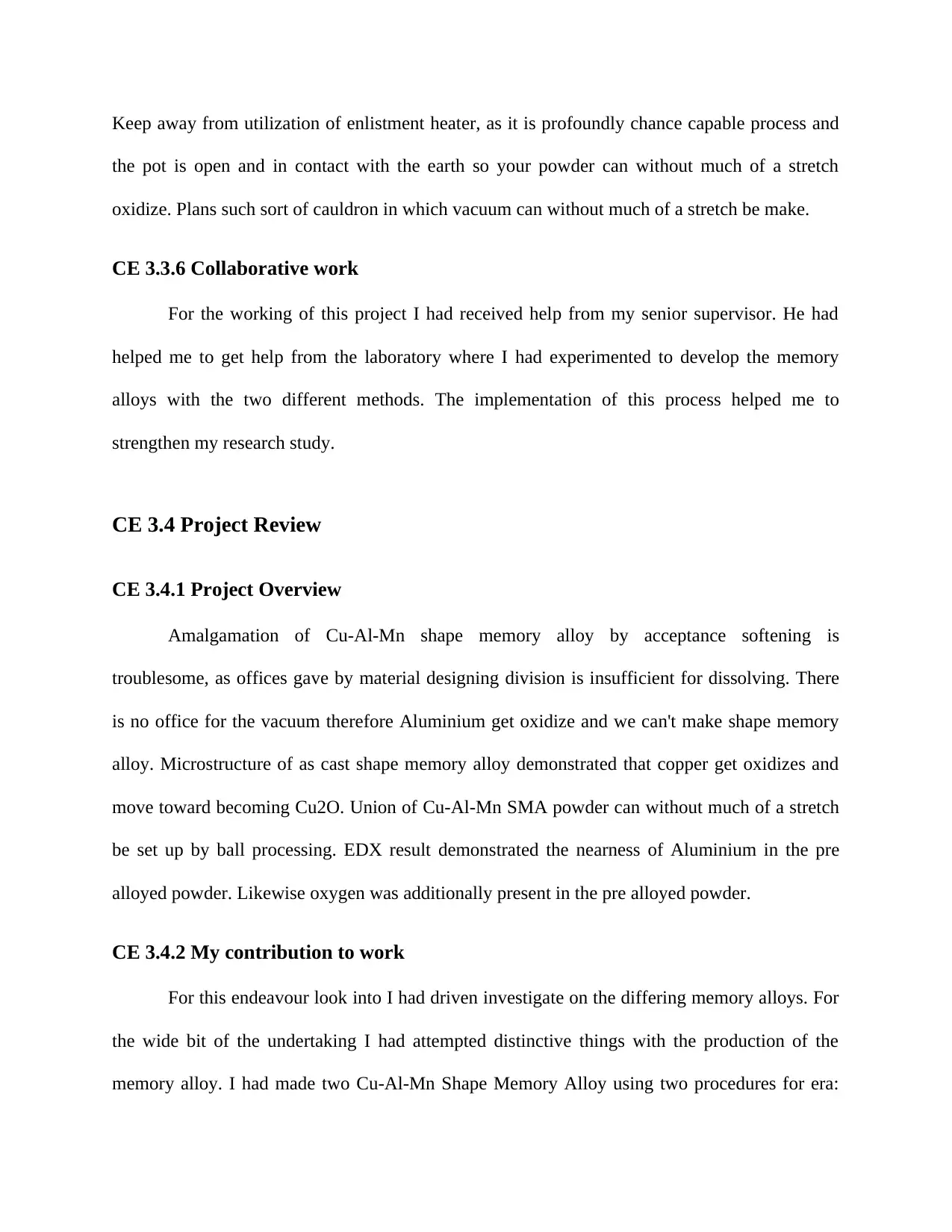
Keep away from utilization of enlistment heater, as it is profoundly chance capable process and
the pot is open and in contact with the earth so your powder can without much of a stretch
oxidize. Plans such sort of cauldron in which vacuum can without much of a stretch be make.
CE 3.3.6 Collaborative work
For the working of this project I had received help from my senior supervisor. He had
helped me to get help from the laboratory where I had experimented to develop the memory
alloys with the two different methods. The implementation of this process helped me to
strengthen my research study.
CE 3.4 Project Review
CE 3.4.1 Project Overview
Amalgamation of Cu-Al-Mn shape memory alloy by acceptance softening is
troublesome, as offices gave by material designing division is insufficient for dissolving. There
is no office for the vacuum therefore Aluminium get oxidize and we can't make shape memory
alloy. Microstructure of as cast shape memory alloy demonstrated that copper get oxidizes and
move toward becoming Cu2O. Union of Cu-Al-Mn SMA powder can without much of a stretch
be set up by ball processing. EDX result demonstrated the nearness of Aluminium in the pre
alloyed powder. Likewise oxygen was additionally present in the pre alloyed powder.
CE 3.4.2 My contribution to work
For this endeavour look into I had driven investigate on the differing memory alloys. For
the wide bit of the undertaking I had attempted distinctive things with the production of the
memory alloy. I had made two Cu-Al-Mn Shape Memory Alloy using two procedures for era:
the pot is open and in contact with the earth so your powder can without much of a stretch
oxidize. Plans such sort of cauldron in which vacuum can without much of a stretch be make.
CE 3.3.6 Collaborative work
For the working of this project I had received help from my senior supervisor. He had
helped me to get help from the laboratory where I had experimented to develop the memory
alloys with the two different methods. The implementation of this process helped me to
strengthen my research study.
CE 3.4 Project Review
CE 3.4.1 Project Overview
Amalgamation of Cu-Al-Mn shape memory alloy by acceptance softening is
troublesome, as offices gave by material designing division is insufficient for dissolving. There
is no office for the vacuum therefore Aluminium get oxidize and we can't make shape memory
alloy. Microstructure of as cast shape memory alloy demonstrated that copper get oxidizes and
move toward becoming Cu2O. Union of Cu-Al-Mn SMA powder can without much of a stretch
be set up by ball processing. EDX result demonstrated the nearness of Aluminium in the pre
alloyed powder. Likewise oxygen was additionally present in the pre alloyed powder.
CE 3.4.2 My contribution to work
For this endeavour look into I had driven investigate on the differing memory alloys. For
the wide bit of the undertaking I had attempted distinctive things with the production of the
memory alloy. I had made two Cu-Al-Mn Shape Memory Alloy using two procedures for era:
Paraphrase This Document
Need a fresh take? Get an instant paraphrase of this document with our AI Paraphraser

Mechanical Ball Milling and Induction Melting. I had also developed the research material for
the experimental findings and the calculations of the development of the two memory alloys.
the experimental findings and the calculations of the development of the two memory alloys.
1 out of 8
Your All-in-One AI-Powered Toolkit for Academic Success.
+13062052269
info@desklib.com
Available 24*7 on WhatsApp / Email
![[object Object]](/_next/static/media/star-bottom.7253800d.svg)
Unlock your academic potential
Copyright © 2020–2025 A2Z Services. All Rights Reserved. Developed and managed by ZUCOL.
